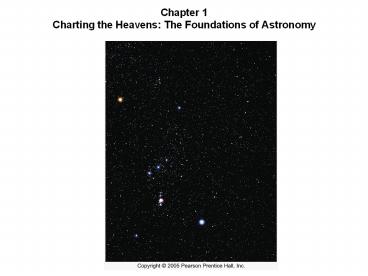Chapter 1 Charting the Heavens: The Foundations of Astronomy PowerPoint PPT Presentation
1 / 28
Title: Chapter 1 Charting the Heavens: The Foundations of Astronomy
1
Chapter 1Charting the Heavens The Foundations
of Astronomy
2
Size of Our Universe
3
Sun, Earth, and Moon
4
Figure 1-3Galaxy
5
Figure 1-4Galaxy Cluster
This photograph shows a typical cluster of
galaxies, roughly a million light-years from
Earth. Each galaxy contains hundreds of billions
of stars, probably planets, and, possibly, living
creatures.
6
Figure 1-9Orion in 3-D
7
Two groups of circumpolar constellations
one we never see.
one we always see.
North circumpolar constellations lie between 49º
N and 90ºN
South circumpolar constellations lie between 41ºS
and 90ºS
8
Figure 1-11Celestial Sphere
Vocab Celestial Equator (CE) Projection of
Earths equator onto the celestial sphere
Celestial Meridian (CM) A circle running
through the celestial poles. Right Ascension
(RA) Measures longitude on the celestial
sphere Declination (DEC) Measures latitude on
the celestial sphere.
9
Figure 1-15The Zodiac
Zodiacal constellations lie along the ecliptic.
The ecliptic is a region of space that the sun
appears to move over one year when viewed from
Earth. The stars we cant see when the sun is up
are eclipsed by the sun.
10
Constellations Near Orion
The 88 constellations span the entire sky. A star
is in a constellation the same way a city or
town is in a state.
11
Figure 1-8Constellation Orion
The stars are connected to show the pattern
visualized by the Greeks the outline of a
hunter. You can easily find this constellation in
the winter sky by identifying the line of three
bright stars in the hunters belt.
12
- The motion of the earth in its orbit causes our
view of the nighttime background stars to be
constantly changing. We associate different
constellations with the seasons - Gemini and Leo with spring
- Scorpio and Hercules with summer
- Cygnus and Lyra with fall
- Orion and Taurus with winter
13
Star Naming
- Johann Bayer designated the brighter stars in
each constellation by a Greek letter. - Stars lettered in order of brightness
- a usually being the brightest and O usually the
faintest - John Flamsteed numbered the stars visible to the
naked eye from west to east across the
constellation. - His systematic method was to name a star by using
a letter or number followed by the Latin name of
the constellation.
14
- When using star charts east and west directions
are opposite in the sky. - To the right is west of the sun
- To the left is east of the sun
15
(No Transcript)
16
(No Transcript)
17
Star Charts
- Find the meridian in the sky using the date and
time. Draw a verticle line. - Find the field of view. Draw a two lines for your
field of view. These are the stars that you can
see on this date. - Note Along the CE you will be able to see
exactly 12 h of RA from horizon to horizon. 6h to
the east of your meridian and 6h to the west.
18
Figure 1-18Precession
19
Figure 1-19Variations in the Solar Day
20
Figure 1-29Triangulation
21
Figure 1-30Geometric Scaling
22
Figure 1-31Parallax
23
Figure 1-32Parallax Geometry
24
Figure 1-33Measuring Earths Radius
25
More Precisely 1-1Angular Measure
26
More Precisely 1-2Celestial Coordinates
27
More Precisely 1-3aMeasuring Distances with
Geometry
28
More Precisely 1-3bMeasuring Distances with
Geometry

